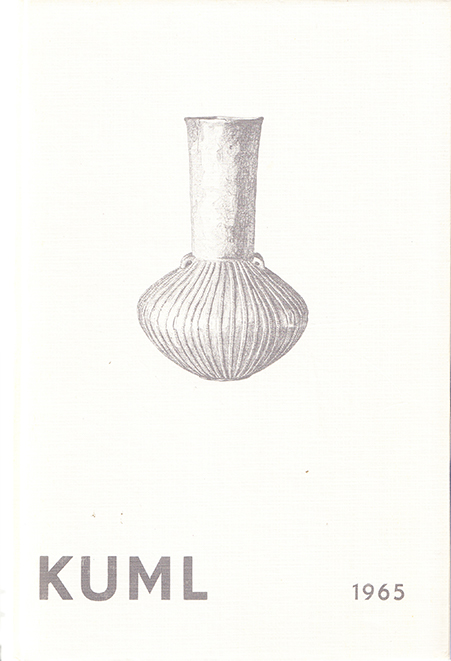Ulbjerg-graven. Begyndelsen af den ældre jernalder i Jylland
DOI:
https://doi.org/10.7146/kuml.v15i15.104494Nøgleord:
early iron age, tidlig jernalder, jutland, jylland, Ulbjerg, grave, grav, Certosa, fibula, fibelResumé
The Beginning of the Early Iron Age in Jutland
The date of the beginning of the Early Iron Age in Denmark is one of the most disputed problems in Scandinavian archaeology. The oldest finds from Jutland (1) have been placed by various authors, in the period between 600 and 400 B.C. (2-3) and discrepancies in dating are mainly due to different conceptions of the relationship between the Central European and North European chronology (4). A few finds, however, can reasonably be employed in a more precise dating, for example the Early Iron Age grave from Ulbjerg in Jutland (5). The grave (fig. 1), a earthgrave, contained an urn, a double spiral brooch, a lug wheel and two fibulae. The urn can be placed with certainty in Period I of the PreRoman Iron Age, where similar types are found in both graves and settlements (6). The same dating applies to the lug wheel (7) and the double spiral brooch (9), both being local forms in Jutland in the first Pre-Roman period (8 and 10). The two fibulae are, however, unique, having no parallel either in Denmark or the other Scandinavian countries. Both have an imitation spring and are presumably modelled on foreign pieces. As a type, they belong to the North European Certosa fibulae (II), distributed (fig. 2) in two main areas around the Oder- Warthe in Poland and along the middle and lower Elbe in Germany. The type originated in Italy (12), spread to Central Europe and thence northwards to Poland and North Germany. There, a number of local variants are recognized (13-16), some of which resemble the Ulbjerg fibulae very closely (15). The type has a wide distribution in Central Europe in the Early Iron Age, which begins at a point corresponding to the Nordic Bronze Age, Periods V and VI (17). In Period VI, the whole of the Polish and North German lowlands exhibit a remarkable uniformity in certain artefacts, for instance needles, toilet equipment and jewellery. This uniformity is based on influence from the Central European Hallstatt Culture. ln Poland, the Late Bronze Age groups from Period VI are followed by the Pommeranian Culture, a group which is primarily characterized by face urns (18). Further west, in Saxony, the Billendorf Culture (19) occurs in Period VI, though its last phase falls outside true Period VI (20) and is probably contemporary with the Pommeranian Culture further east. Further north, along the Elbe, the period VI inventory shows striking similarities to Danish Period VI (21), and via these regions the latest Nordic Bronze Age Culture had had a connection with the Central European Hallstatt Culture. After Period VI, these regions display the Jastorf Culture which maintains contact with Jutland in the first period of the Pre-Roman Iron Age (22).
If the dating of the Certosa fibulae is examined, it appears that in the east they belong to the Pommeranian Culture (23), which has metal forms resembling in certain respects those of Period l of the Pre-Roman Iron Age in Jutland. Further west, Certosa fibulae are found in Saxony in the last phase of the Billendorf Culture (26), i. e. that part of it which is later than Period VI. In the north, Certosa fibulae occur in the earliest phase of the Jastorf Culture (27). Sometimes this phase exhibits fibulae with the foot shaped as an animal head (28). Certosa fibulae are thus in Poland, North Germany and Denmark placed in the first Pre-Roman period.
How, then, are Certosa fibulae dated in relation to the division which hes been made of Ha D (30)? Certosa fibulae and fibulae with animal-head feet are sometimes found together in integral finds (32) and the latest investigations seem to show that both types begin before true La Tene A (33), i. e. at a point corresponding to the transition between Ha D 2 and D 3. In the absolute chronology (34), Certosa fibulae would then be dated c. 500, and this should largely correspond to the beginning of the Pre-Roman Iron Age in Denmark. This is a confirmation of the date given in the latest survey of the Early Iron Age in Jutland (35).
Jørgen Jensen.Downloads
Publiceret
Citation/Eksport
Nummer
Sektion
Licens
Fra og med årgang 2022 er artikler udgivet i Kuml med en licens fra Creative Commons (CC BY-NC-SA 4.0).
Alle tidligere årgange af tidsskriftet er ikke udgivet med en licens fra Creative Commons.


